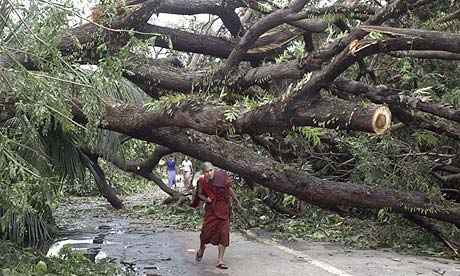- Ian MacKinnon, south-east Asia correspondent and Julian Borger, diplomatic editor
- The Guardian,
- Tuesday May 6 2008
- Article history

A monk makes his way past a fallen tree following the cyclone in Burma. Photograph Barry Broman/AP
An international relief effort was mobilising last night after Burma's military rulers estimated that 10,000 people had been killed in a cyclone at the weekend and acknowledged they were willing to accept foreign help.
Aid workers believe at least 1 million people have been left homeless by Cyclone Nargis, which barrelled across south-west and central Burma on Saturday, unleashing 120mph (190kmph) winds, torrential rains and flooding that caused a catastrophic trail of destruction.
The reclusive military government initially said casualties ran into the hundreds, but dramatically revised the toll yesterday.
The foreign minister, Nyan Win, told diplomats the number of dead could reach 10,000, with at least 3,000 still missing, making it the worst natural disaster in east Asia since the 2004 tsunami.
Andrew Kirkwood, country director of Save the Children, whose teams began distributing aid, said: "Older people I've spoken to in Yangon [Rangoon] say this is the worst storm they've seen in the 60 years they've been alive. Everyone recognises this was unprecedented."
The worst-affected areas in the Irrawaddy delta have still to be reached, but several towns were completely flattened and many villages along the coast were covered in mud when the storm surge subsided.
In one delta town alone, Bogalay, 2,879 people were missing, fuelling fears that the numbers could rise dramatically.
Save the Children estimated that in the outlying area of Rangoon where it works, between 50,000 and 100,000 people had no shelter after their flimsy homes were wrecked.
"I think more than 1 million people could be homeless very easily," said Kirkwood, speaking from Rangoon. "There are 7 million living in the Irrawaddy delta area and it has been hugely affected with 90% to 95% of houses destroyed in some places."
The scale of the destruction is so immense that ministers in the Burmese regime, always intensely suspicious of international aid agencies, asked for outside assistance, a move the government shunned even during the 2004 tsunami.
The World Food Programme (WFP) said it had been given a "careful green light" and added that the UN was now working out how to deliver aid to the country as quickly as possible.
"The government indicated willingness to accept international assistance through the UN agencies," said WFP spokesman Paul Risley. "I'd say it was a careful green light."
Clean drinking water is a pressing need, particularly in Rangoon, a city of 6 million, where those without wells are in desperate need after supplies were cut. Effective sanitation is also needed to prevent the spread of disease and life-threatening diarrhoea.
Aid agencies already on the ground in Burma began distributing food, plastic sheeting, buckets, cooking utensils and water purification tablets yesterday. But the UN office in Rangoon said there was an urgent need for more plastic sheeting, mosquito nets, health kits and food.
Neighbouring Thailand responded by sending nine tonnes of medicines and food by military transport to Rangoon's international airport, which reopened yesterday.
India, which maintained close relations with the Burmese government throughout last year's political crisis, said two navy ships from Port Blair would sail immediately for Rangoon carrying food, tents, blankets, clothing and medicine.
The cyclone struck at a time when the regime is under intense international pressure to democratise following the widespread suppression of street protests last year. The ruling junta blamed the protests on foreign interference.
A British foreign office minister, Meg Munn, issued a statement saying: "The priority must be to mobilise aid to all those affected to avoid further suffering. We call on the Burmese regime to provide rapid support to its people and to accept international assistance."
The European Union said it would provide €2 million (£1.57m) in urgent humanitarian aid for the cyclone victims.
"With every hour that passes, the news coming out of Myanmar [Burma] gets grimmer and grimmer," said the development commissioner, Louis Michel. "This is a terrible catastrophe that demands a quick and effective humanitarian response."
Residents of Rangoon, including groups of monks, joined forces during the day in an effort to clear the roads of downed trees and telegraph poles.
Traffic in the city was described as "horrendous" because most of the roads were reduced to narrow arteries by debris, but at least it afforded an opportunity to get aid to outlying areas.
Electricity remained cut off in most of the city, forcing people to queue to buy candles which, along with other foodstuffs and supplies, have increased in price dramatically.
Aid workers were concerned that without access to water people in the city were washing in the lakes, where the supply was already considered a health hazard.
"In the city the main problem, absolutely, is water," said Kirkwood. "In the urban areas, the water is less of a problem. But people without shelter are gathering in schools, monasteries and temples where sanitation is the worry. We've examples of 1,000 and 1,500 altogether."
Last night an exiled political prisoners' group said Burmese soldiers and police had killed 36 inmates of Rangoon's notorious Insein jail after a riot started in the wake of cyclone.
The Assistance Association for Political Prisoners in Burma said that after the storm had ripped off cell roofs, 1,000 inmates had been herded into a hall and the doors were locked. The prisoners lit a fire inside the hall, but panic ensued when the hall filled with smoke and riot police and soldiers called in to quell the commotion opened fire, killing 36 and wounding 70.
However, the regime yesterday signalled that it would press ahead with Saturday's referendum on the draft constitution despite the turmoil.








